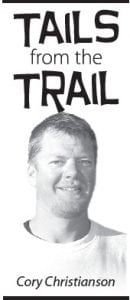There was an unfamiliar noise in the woods while ice fishing last weekend on a lake that is ‘pert near the Boundary Waters. At first I thought it was just an obnoxiously loud exhaust pipe on a snowmobile in the distance that was echoing between the granite shorelines, but to my surprise a helicopter appeared in the sky.
We watched the chopper fly back and forth across the shorelines for about 10 minutes, at one point they were close enough to throw us a wave while we sat on our buckets jigging for lake trout. There were no U.S. Forest Service or Department of Natural Resources markings on the helicopter so it is likely that it belonged to the moose research team that collared 100 adult moose and 34 calves last winter.
The sophisticated GPS collars are able to give researchers locations and movements while also relaying the animal’s temperature. In July, we lost moose No. 90 due to a compound leg fracture and infections from a predatory attack. Researchers knew the moose was in trouble since her temperature spiked (most likely during the attack) and then remained high while the moose began to slow down. They receive an update every four hours and were able to locate the moose partially submerged in a lake attempting to cool off. The moose was found floating in the same lake the next day and was removed by the research team.
The Minnesota DNR website has more information about the collaring program and they break down the mortality information for both adults and calves in a pie chart. The report makes it easier to understand the diverse challenges moose endure in order to survive up here, especially the calves.
Our northern Minnesota population of moose has decreased by 52 percent since 2010. The Minnesota Moose Research and Management Plan is also available to read on the DNR website and is very interesting. The plan itself is very structured and wordy, like I would expect a government plan to be, but the research that follows is very interesting.
Knowing the history of the moose is an important component in understanding its future. I am saddened at the thought of taking my grandchildren to a zoo to see their first moose, but at least we will know why.
Cory Christianson has worked as a fishing guide on the Gunflint Trail since 2000. If you have any fishing or wildlife reports or stories to share, send an email to: christiansoncory@hotmail.com or call 218- 388-0315. You can also visit Cory’s website at Gunflintfishingguide.com.



Loading Comments